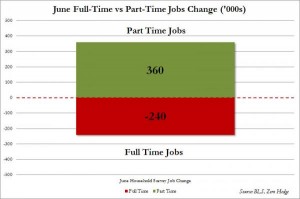What would be a more effective way to increase employment and boost the economy – continue quantitative easing or repeal Obamacare?
The answer is obvious to anyone paying attention. After more than five years of quantitative easing and nearly $4 trillion in bond buying, the unemployment rate is still 7.6%, which is well above the targeted rate of 6.5%.
But, as we’ve pointed out before, that U-3 unemployment rate is deceiving, as it doesn’t include people who have given up looking for work and it counts part-time employees as if they were fully employed.
As we reported in April, 90 million Americans had given up looking for work, which is why the unemployment rate dropped to 7.6%.
Meanwhile, though, part-time employment has set a new record. In June, the number of part-time jobs soared by 360,000 to 28,059,000, while full-time jobs dropped by 240,000. So far in 2013, only 130,000 full-time jobs have been added, compared with 557,000 part-time jobs.
The increase in part-time workers appears to be linked to the Affordable Care Act, aka Obamacare. Not unexpectedly, businesses are doing everything they can to avoid the mandates of Obamacare, which include a requirement that employers with 50 employees or more provide health insurance coverage for anyone working 30 hours a week or more or pay a penalty of $2,000 per employee.
Employers can avoid the penalty by employing workers for fewer than 30 hours a week.
Delaying the Mandate
In spite of an unceremonious semi-announcement this week that large employers will have an extra year to comply with Obamacare, the mandate requiring individuals to have healthcare coverage is still scheduled to take effect on Jan. 1, 2014. The announcement of the delay was posted on the blog of the assistant treasury for tax policy on the evening of July 2.
Whether the extension was provided because the government is ill-prepared to carry out its mandate, 2014 is an election year or the government wants to boost hiring, it’s likely to have little impact on the unemployment rate.
Even with the employer mandate delayed until Jan. 1, 2015, employers are unlikely to increase fulltime employment this year, knowing that they will be unable to afford their new employees a year from now, just as they are trained and becoming more productive.
Government’s Response
So quantitative easing will continue, the unemployment rate will remain high and economic growth will remain low. The stock market has continued to benefit, but how long will it be before investors realize that the improving economy is a mirage?
